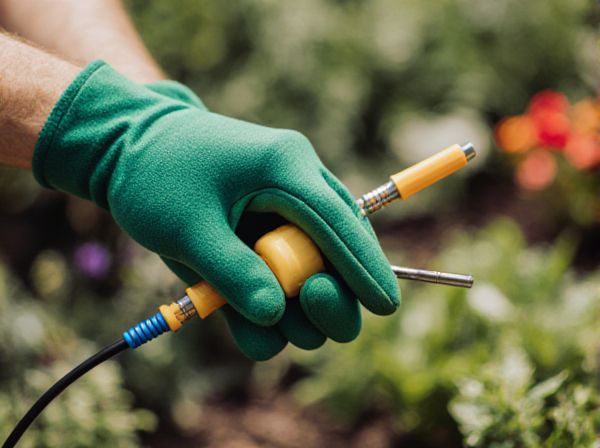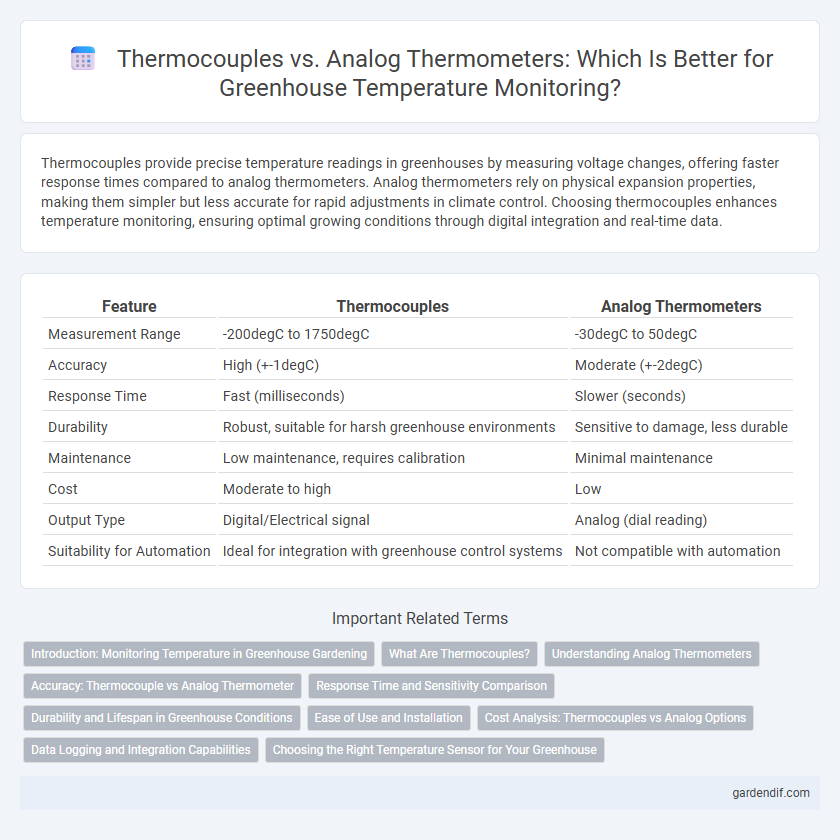
Thermocouples vs Analog Thermometers Illustration
Thermocouples provide precise temperature readings in greenhouses by measuring voltage changes, offering faster response times compared to analog thermometers. Analog thermometers rely on physical expansion properties, making them simpler but less accurate for rapid adjustments in climate control. Choosing thermocouples enhances temperature monitoring, ensuring optimal growing conditions through digital integration and real-time data.
Table of Comparison
| Feature | Thermocouples | Analog Thermometers |
|---|---|---|
| Measurement Range | -200degC to 1750degC | -30degC to 50degC |
| Accuracy | High (+-1degC) | Moderate (+-2degC) |
| Response Time | Fast (milliseconds) | Slower (seconds) |
| Durability | Robust, suitable for harsh greenhouse environments | Sensitive to damage, less durable |
| Maintenance | Low maintenance, requires calibration | Minimal maintenance |
| Cost | Moderate to high | Low |
| Output Type | Digital/Electrical signal | Analog (dial reading) |
| Suitability for Automation | Ideal for integration with greenhouse control systems | Not compatible with automation |
Introduction: Monitoring Temperature in Greenhouse Gardening
Thermocouples provide precise, real-time temperature readings crucial for maintaining optimal growing conditions in greenhouse gardening. Analog thermometers, while simple and cost-effective, lack the accuracy and rapid response needed for dynamic environment control. Integrating thermocouples enhances climate monitoring systems, ensuring healthier plant growth and improved crop yields.
What Are Thermocouples?
Thermocouples are temperature sensors that consist of two different metal wires joined at one end, producing a voltage correlated to temperature changes. They offer rapid response times and a wide measurement range, making them suitable for precise monitoring in greenhouse environments. Unlike analog thermometers, thermocouples provide digital output compatible with automated climate control systems, enhancing accuracy and efficiency.
Understanding Analog Thermometers
Analog thermometers in greenhouses rely on physical expansion of fluids or metals to measure temperature, providing real-time readings through a calibrated scale. Unlike thermocouples, which generate voltage signals converted by electronic devices, analog thermometers offer simplicity, durability, and no need for power sources. Their direct visual display makes them effective for quick temperature assessments critical in maintaining optimal greenhouse conditions.
Accuracy: Thermocouple vs Analog Thermometer
Thermocouples provide higher accuracy in temperature measurement within greenhouses, often detecting changes as precise as +-0.1degC, compared to analog thermometers which typically offer +-1degC precision. The rapid response time and digital output of thermocouples enable more reliable real-time monitoring of environmental conditions critical for plant growth. This improved accuracy supports optimized climate control and enhances crop yield and quality.
Response Time and Sensitivity Comparison
Thermocouples offer faster response times compared to analog thermometers, typically detecting temperature changes within milliseconds, which is crucial for maintaining precise greenhouse climates. Their higher sensitivity allows thermocouples to measure smaller temperature fluctuations accurately, enhancing environmental control and plant health. Analog thermometers, while reliable, generally have slower response times and lower sensitivity, making them less effective for dynamic temperature monitoring in greenhouse settings.
Durability and Lifespan in Greenhouse Conditions
Thermocouples offer superior durability compared to analog thermometers, with the ability to withstand high humidity, temperature fluctuations, and corrosive greenhouse environments without degradation. Their lifespan often exceeds five years under typical greenhouse conditions, whereas analog thermometers are prone to mechanical wear and calibration drift, often requiring replacement within one to two years. Selecting thermocouples ensures more reliable temperature monitoring and reduces maintenance costs in controlled horticultural settings.
Ease of Use and Installation
Thermocouples offer easier installation in greenhouses due to their compact size and ability to connect directly to digital controllers without extensive wiring. Analog thermometers, while simple to read, often require manual placement and lack integration with automated systems, making them less convenient for continuous monitoring. The low maintenance and quick response time of thermocouples enhance ease of use in dynamic greenhouse environments.
Cost Analysis: Thermocouples vs Analog Options
Thermocouples generally offer a more cost-effective solution compared to analog thermometers, especially in large-scale greenhouse operations where precise temperature monitoring is critical. Though analog thermometers have lower upfront costs, their maintenance and calibration expenses can accumulate over time, making thermocouples more economical due to their durability and minimal upkeep requirements. Investing in thermocouples often results in better long-term savings and enhanced temperature accuracy for greenhouse environmental control.
Data Logging and Integration Capabilities
Thermocouples provide precise temperature measurements with high responsiveness and are easily integrated into automated data logging systems through digital interfaces, enabling real-time monitoring and historical analysis in greenhouse environments. Analog thermometers, while reliable for basic readings, lack connectivity and cannot directly interface with digital data loggers, limiting their usefulness in advanced climate control systems. Utilizing thermocouples enhances data accuracy and facilitates seamless integration with greenhouse management software for optimized environmental control.
Choosing the Right Temperature Sensor for Your Greenhouse
Thermocouples offer rapid response times and a wide temperature range, making them ideal for dynamic greenhouse environments where precise monitoring is crucial. Analog thermometers provide simplicity and durability but lack the accuracy and digital integration capabilities necessary for advanced climate control systems. Selecting the right temperature sensor depends on your greenhouse's automation needs, temperature fluctuation patterns, and budget constraints.
Thermocouples vs Analog Thermometers Infographic

 gardendif.com
gardendif.com